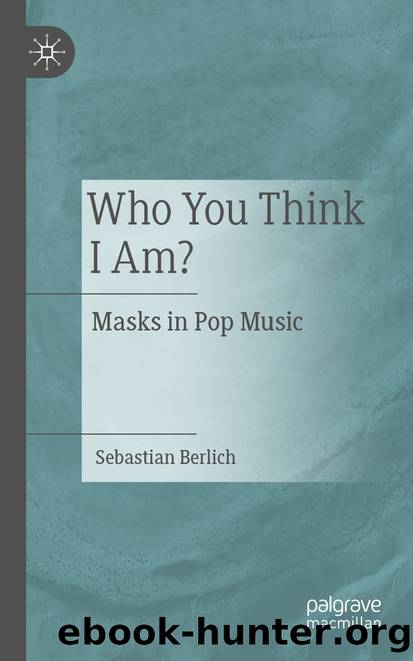Who You Think I Am? by Sebastian Berlich

Author:Sebastian Berlich
Language: eng
Format: epub
ISBN: 9783662672525
Publisher: Springer Berlin Heidelberg
The Mask in Serial Production
But the logo does even more: Not only does it hold the style community together, it symbolizes mythology, charges itself with this and is dependent on authentication in consumption and feedbackâthe logo must also be recognizable over a longer period of time. The mask can do this, at least theoretically, more effectively than the face exposed to change. The face or the mask is a reliable, central sign of the media biography, which runs chaotically through reception and production on several channels, but at least on the production side is serially designed. Bringing together pop and series is certainly not a new idea, on the contraryâonly Venusâ thesis should be mentioned that spectacularly self-referential images go directly into series. However, research has hardly discussed how this seriality is expressed in pop music.
Having said that, the way in which the most diverse styles of pop music have been grouped around the album format for a long time and often still today invites us to understand this format as gravitational centers within media biographies. Roy Shuker captures this serial process excellently on the production side: âCreating and working up new musical material for performance, studio and home recording, and touring, and once again back to creating and recording to keep the momentum goingâ (Shuker 2016, p. 52). This already announces the âdialectic between order and novelty or schema and innovationâ (Eco 1988b, p. 167) described by Umberto Eco as the central principle of the seriesâin essence, the schematic process is repeated, but it must always appear new (here I neglect a culture critical connotation).
What Eco calls schema is Machoâs tautology and the ideal state for the logo itself; what an essay by Werner Faulstich et al. 1997 still describes with a view to television stars as the diachronic continuity of the star image. This continuity must be established again and again, against the interference of reception and the centrifugal forces of diachronic development, which also apply to media biographies (in the sense of the series; cf. Kelleter 2012, pp. 20â24). The authors also think continuity synchronously, which is about a relationship to be authenticated between person and role; diachronically, the challenge is to maintain the balance, to move within the image, but also to process crises (cf. Faulstich et al. 1997, pp. 27â28). In pop music, the relationship is even more complicated, because here innovation is anchored not only in the means of coping with crises, but also in the modernist and consumerist understanding of the genre (cf. e.g. Reynolds 2012). The mask can minimize contingencies: Every look sits, an image can be easily launched and maintained over a long period of time. Johannes Gruber, for example, notes on Sido: âThe rapper wears the silver mask throughout the video, which became his trademark for several years and thus served as a coherence-forming medium of profile buildingâ (Gruber 2017, p. 265). And in the already quoted BBC documentary, Corey Taylor emphasizes that the mask helps him to put himself in his former self and thus to establish constancy within the band (cf.
Download
This site does not store any files on its server. We only index and link to content provided by other sites. Please contact the content providers to delete copyright contents if any and email us, we'll remove relevant links or contents immediately.
Maria Montessori by Marjan Schwegman(189)
DIN ISO 7000:2008-12 by Unknown(182)
DIN ISO 7168-2 by Unknown(166)
silence-2005 by Unknown(161)
Jasper by Forum shopping in England und Deutschland (9783428468829)(154)
Abraham by Betriebspädagogik (9783428441822)(146)
shostakovich preludes and fugues no 20p by Unknown(145)
Hahn by Schuldrecht AT – leicht gemacht (9783874407496)(142)
shostakovich preludes and fugues no 08p by Unknown(141)
shostakovich preludes and fugues no 06p by Unknown(140)
shostakovich preludes and fugues no 10f by Unknown(138)
Melchior by Gesellschaftsrecht – leicht gemacht (9783874407410)(137)
Our Nig; Or, Sketches from the Life of a Free Black by Harriet E. Wilson(134)
shostakovich preludes and fugues no 20f by Unknown(134)
Beck by Schriften zum Steuerrecht (9783428513727)(133)
DIN VDE 0260-306-4 by Unknown(133)
Clemens by Steuerprozesse zwischen Privatpersonen (9783428446643)(131)
Industry 4.0 The Industrial Internet of Things (C4dR) by Unknown(130)
Peter by Arbeitsrecht in Familienunternehmen (9783428554195)(125)
